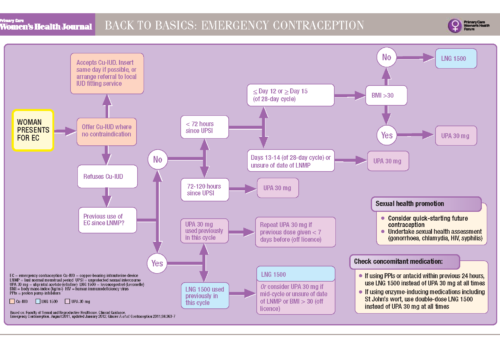Nausea and vomiting in pregnancy (NVP) are regarded as a ‘normal’ phenomenon of early pregnancy, and so their impact is under-appreciated and under-researched. The condition can, however, be so serious that women need admission for fluid replacement. GPs and practice nurses looking after women with NVP need to be aware of its potential severity and be willing to offer safe and effective therapy.
Emergency contraception: Towards a multidisciplinary consensus
This supplement is sponsored by HRA Pharma, on behalf of whom the Expert Working Group was convened and funded. Editorial control has remained with the authors and the journal at all times. HRA Pharma reviewed the text for regulatory accuracy just prior to printing.
Editorial
Last time I shared my thoughts with you, I was eagerly anticipating the Department of Health’s sexual health policy document for England. Indeed, since publication was promised for spring 2012, I was worried that my comments might be overtaken by events. But the policy will now appear some time this summer, and I am concerned that the resulting delay and uncertainty mean that there may be little time to ensure that we maintain standards of local contraception and sexual health services.
Breaking the vicious cycle of chronic pelvic pain
Chronic pelvic pain presents in general practice at the same rate as asthma and back pain, and is one of the most common reasons for referral to a gynaecologist. Since chronic pelvic pain is a symptom rather than a diagnosis, a thorough history and examination are essential to avoid a sometimes vicious cycle of referrals or investigations that only cause further anxiety for the patient.
Back to Basics: Emergency contraception
Based on: Faculty of Sexual and Reproductive Healthcare. Clinical Guidance. Emergency Contraception. August 2011, updated January 2012; Glasier A et al. Contraception 2011;84:363-7
Lessons from the Contraceptive CHOICE Project
Increased use of intrauterine contraceptives (IUCs) and implants for regular contraception could significantly reduce the incidence of unintended pregnancy. It has, however, proved challenging to promote use of these long-acting reversible contraceptives (LARCs) in clinical practice. This article explains how lessons from a successful project in the USA are being used to encourage the uptake of LARCs among women in Hull.
Time to think about women with epilepsy
Each year 2,500 women with epilepsy have a baby, and before they conceive only 46% are aware that their condition could affect their unborn child. It is essential to encourage women with epilepsy to think about contraception, conception and pregnancy, and the Quality and Outcomes Framework (QOF) now includes an indicator for these very issues.
Taking the right route to ovarian cancer diagnosis
Recommendations from the National Institute for Health and Clinical Excellence (NICE) aim to prompt rapid investigation of women with patterns of symptoms suggestive of ovarian cancer. But this is just one of a plethora of guidance for primary care, and incorporating it into our daily practice remains challenging. So how should we apply the NICE ovarian cancer guidelines to our patients?
Revealing the truth about labial reduction
Increasing numbers of healthy women are asking their GPs to refer them for labial reduction. This does not just have potentially important cost implications for service commissioners. There are also considerable ethical issues for GPs to consider before referring women for this form of female genital cosmetic surgery.
Lichen sclerosus
Getting it right for our women – the Forum’s next steps
In these uncertain times for contraception and sexual health services, the voice of the Primary Care Women’s Health Forum is becoming ever more important. We have been very active in formulating our latest plans, so that we can respond to our members’ concerns and ensure that we protect services for women.
The rise of gestational diabetes
As obesity rates continue to soar in women of reproductive age, gestational diabetes mellitus (GDM) is an increasingly important and prevalent problem. Appropriate recognition and careful management of GDM are essential. This will not only improve the outcomes of pregnancy, but may also have a beneficial effect on a woman’s lifelong risk of developing type 2 diabetes.

























